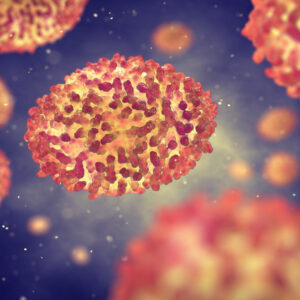Poxviruses
Poxviruses are large oval-shaped viruses. Poxviruses are unique among DNA viruses, as they replicate only in the cytoplasm of the host cell, outside of the nucleus. Therefore, a large genome is required for encoding various enzymes and proteins involved in viral DNA replication and gene transcription.
Poxviruses exist throughout the world, vertebrates and arthropods serve as natural hosts. Poxvirus infections typically result in the formation of lesions, skin nodules, or disseminated rash.
A wide spread outbreak of the viral disease Mpox was confirmed in May 2022, predominantly in Europe, but laboratory confirmed cases were soon reported in North and South America, Asia, Africa, and Australia.
Poxvirus Background
Mpox is a zoonotic virus of the orthopoxvirus genus of the Poxviridae family, and is typically endemic in Central and West Africa. The main animal reservoir has not been conclusively determined but is considered to be rodents. (https://www.who.int/news-room/fact-sheets/detail/monkeypox) Animal to human and human to human transmission requires close contact with bodily fluids or respiratory secretions. (https://www.who.int/news-room/fact-sheets/detail/monkeypox)
In early May 2022 , a small number of monkeypox cases were reported in the UK, Spain, and elsewhere in Europe; The identification of confirmed and suspected cases of monkeypox with no direct travel links to an endemic area represented a highly unusual event.
By early July 2022 almost 8,000 confirmed cases had been reported from 63 Member States in five World Health Organization (WHO) Regions.
Despite mild disease progression in most healthy individuals symptoms can be severe in immunocompromised patients, children, and pregnant women. Complications can include secondary infections, sepsis and blindness (https://www.who.int/news-room/fact-sheets/detail/monkeypox). The case fatality ratio of monkeypox has historically ranged from 0 to 11 % in the general population and has been higher among young children. In recent times, the case fatality ratio has been around 3–6% ( https://www.who.int/news-room/fact-sheets/detail/monkeypox). There are no therapeutics (WHO page https://www.who.int/news-room/fact-sheets/detail/monkeypox says smallpox antiviral agent is licensed – tecovirimat but isn’t widely available), and early detection of infection becomes crucial for containment.
Modified Vaccinia Ankara (MVA), manufactured as a smallpox vaccine, provides some protection against Mpox. Observational studies put the effectiveness at around 85%. However, cross-protective immunity from smallpox vaccination will be limited to older persons, since populations under the age of 40 or 50 years no longer benefit from the protection afforded by prior smallpox vaccination campaigns. A newer licensed vaccine from 2019 also offers protection but currently has limited availability. (https://www.who.int/news-room/fact-sheets/detail/monkeypox) Monkeypox has been under scrutiny due to waning immunity from the end of routine smallpox vaccination in the 1980s and the potential for it to become a more efficient human pathogen (https://www.ncbi.nlm.nih.gov/pmc/articles/PMC2567051/ )
Poxvirus Antigens
Following an international outbreak of Mpox in early 2022, we now offer a number of antigens to support the research and diagnosis of this emerging disease.
We offer recombinant Vaccinia virus B18R protein, which contains two Ig-like C2-type domains and one Ig-like V-type domain
Questions?
Check out our FAQ section for answers to the most frequently asked questions about our website and company.

